Papers by Elisabet Londos

Acta Radiologica, 2008
Medial temporal lobe atrophy (MTA) is an early sign of Alzheimer's diseas... more Medial temporal lobe atrophy (MTA) is an early sign of Alzheimer's disease (AD). The current method of choice for measuring MTA is volumetric measurement based on 3D magnetic resonance imaging (MRI), but this complicated method has not been implemented clinically. To investigate whether simple computed tomography (CT) linear measurements of the brain could be of value in AD workup. Fifty-nine healthy control subjects and 248 AD subjects were recruited. They were evaluated using a comprehensive clinical workup. A series of linear CT measurements were obtained from brain CT. In discriminant analysis, the temporal horn ratio and the suprasellar cistern ratio were the atrophy factors that contributed most significantly to the diagnoses. Combined with other clinical factors (apolipoprotein E4 genotype), a correct AD classification of 90.2% was achieved. CT linear measurements could be of value in the workup of AD patients, considering the inexpensiveness and availability of CT as well as the simplicity of linear measurements.
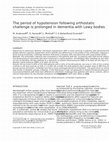
International Journal of Geriatric Psychiatry, 2008
Objectives To determine whether orthostatic hypotension (OH) is more common in patients with deme... more Objectives To determine whether orthostatic hypotension (OH) is more common in patients with dementia than in older people without cognitive impairment and to identify key differences in the profile of the orthostatic response and the pulse drive during orthostatic challenge between Alzheimer's disease (AD) and dementia with Lewy bodies (DLB). Methods The orthostatic response was evaluated in 235 patients with AD, 52 patients with DLB and 62 elderly controls. The blood pressure and pulse rate were measured in supine position, immediately after standing up and after 1, 3, 5 and 10 min of standing. OH was defined as a reduction of systolic blood pressure (SBP) of at least 20 mm Hg or a reduction of diastolic blood pressure (DBP) of at least 10 mm Hg. Results OH occurred in 69% of the DLB patients and in 42% of the AD patients, but only in 13% of the controls ( p < 0.001 controls vs AD and controls vs DLB, p ¼ 0.001 AD vs DLB) The DLB patients had a greater drop in SBP than the other study groups during orthostatic challenge and had a more prolonged period of orthostasis. The pulse drive on orthostatic challenge was similar in between groups. However, in the DLB group it was not adequate to restore the blood pressure to supine values. Conclusions Patients with DLB react different to orthostatic challenge than patients with AD or controls, with important clinical implications for key disease symptoms and treatment.
European Neurology, 2010
Aim: To examine the incidence of post-lumbar puncture headache (PLPH) in patients admitted for co... more Aim: To examine the incidence of post-lumbar puncture headache (PLPH) in patients admitted for cognitive disturbances. Methods: The incidence of PLPH and other general (subdural hematoma, meningitis, encephalitis) or local (local pain, spinal hematoma, local infection) complications was evaluated in 1,089 consecutive patients (aged 23–89 years) who underwent lumbar puncture as a part of the routine diagnostic evaluation between February
Neurobiology of Disease, 2007
We aimed to determine plasma and cerebrospinal fluid (CSF) levels of angiotensin-converting enzym... more We aimed to determine plasma and cerebrospinal fluid (CSF) levels of angiotensin-converting enzyme (ACE) and the soluble forms of intercellular adhesion molecule-1 (sICAM-1), vascular cell adhesion molecule-1 (sVCAM-1) and platelet endothelial cell adhesion molecule-1 (sPECAM-1) as surrogate markers for endothelial cell activation in clinically diagnosed patients with Alzheimer’s disease (AD, n=260), dementia with Lewy bodies (DLB, n=39) and non-demented controls
Archives of Gerontology and Geriatrics, 2003
This study was undertaken in order to compare regional cerebral blood flow (rCBF) and EEG finding... more This study was undertaken in order to compare regional cerebral blood flow (rCBF) and EEG findings of patients with clinically diagnosed dementia with Lewy bodies (clinDLB) and Alzheimer's disease (clinAD). Furthermore, within the clinDLB group to compare cases with and without neuropathologically verified Lewy bodies (LBs). When we studied 200 dementia cases in a prospective longitudinal dementia study, 48 had

International Psychogeriatrics, 2010
Dementia with Lewy bodies (DLB) accounts for 15-20% of the millions of people worldwide with deme... more Dementia with Lewy bodies (DLB) accounts for 15-20% of the millions of people worldwide with dementia. Accurate diagnosis is essential to avoid harm and optimize clinical management. There is therefore an urgent need to identify reliable biomarkers. Mass spectrometry was used to determine the specificity of antibody alpha-synuclein (211) for alpha-synuclein. Using gel electrophoresis we measured protein levels detected by alpha-synuclein specific antibodies in the cerebrospinal fluid (CSF) of DLB patients and compared them to age matched controls. A 24 kDa band was detected using alpha-synuclein specific antibodies which was significantly reduced in the CSF of DLB patients compared to age matched controls (p &amp;amp;amp;amp;amp;amp;amp;amp;amp;amp;amp;amp;amp;amp;amp;amp;amp;amp;amp;amp;amp;amp;amp;amp;amp;amp;amp;amp;amp;amp;amp;amp;amp;amp;amp;amp;amp;amp;amp;amp;amp;amp;amp;amp;amp;amp;amp;amp;amp;amp;amp;amp;amp;amp;amp;amp;amp;amp;amp;amp;amp;amp;amp;amp;amp;amp;amp;amp;amp;amp;amp;amp;amp;amp;amp;amp;amp;amp;amp;amp;amp;amp;amp;amp;amp;amp;amp;amp;amp;amp;lt; 0.05). Further analysis confirmed that even DLB patients with mild dementia showed significant reductions in this protein in comparison to controls. The current study emphasizes the necessity for further studies of CSF alpha-synuclein as a biomarker of DLB and extends our previous knowledge by establishing a potential relationship between alpha-synuclein and the severity of cognitive impairment. The identification of this 24 kDa protein is the next important step in these studies.
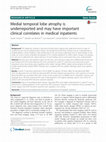
BMC Geriatrics, 2015
Background: The diagnostic workup in dementia includes brain imaging with reading focussed on sig... more Background: The diagnostic workup in dementia includes brain imaging with reading focussed on signs of cerebrovascular and neurodegenerative disease. We hypothesised that these findings may be underreported in hospital patients, where imaging is often performed to rule out obvious pathology such as haemorrhage. In this study, we review cranial computed tomography (CT) in medical inpatients for white matter changes and atrophy. Our aim was to determine the clinical relevance of such findings and to what extent they were underreported. Methods: Records from 200 inpatients aged over 60 years, who had been subjected to MMSE (mini-mental state examination) and CDT (clock-drawing test), were reviewed for cranial CT. Transverse and coronal slices were reassessed using visual rating scales regarding white matter changes (WMC), global cortical atrophy (GCA) and medial temporal lobe atrophy (MTA). Findings were compared with the original radiology reports and cognitive test results. Results: Cranial CT had been performed in 94 of 200(47 %) patients. Of these, 58(62 %) had abnormal WMC, 35(37 %) abnormal GCA and 34(36 %) abnormal MTA. All three findings had associations with cognitive test results. Abnormal MTA was associated with lower results on the overall score on MMSE and on orientation, memory and language items. All three measurements were underreported in the original radiology reports; none of the 34 patients with abnormal MTA had been reported originally. Conclusions: Signs of neurodegenerative disease, especially MTA, were highly underreported in cranial CT scans performed in medical inpatients. At the same time, MTA seemed to hold the most important clinical correlates. Our results suggest that MTA should be reported more regularly in this setting.

Clinical interventions in aging, 2014
Many individuals with Alzheimer's disease (AD) live alone, and this figure is expected to inc... more Many individuals with Alzheimer's disease (AD) live alone, and this figure is expected to increase. This study aimed to describe the cognitive and functional abilities of solitary-living AD patients, and the potential predictors of their usage of community-based services. This 3-year, prospective, multicenter study included 1,021 participants with mild-to-moderate AD (Mini-Mental State Examination score, 10-26) treated with a cholinesterase inhibitor in a routine clinical setting. At baseline and every 6 months, patients were assessed using cognitive, instrumental, and basic activities of daily living (ADL) scales, and service utilization was recorded. Logistic regression models were used to predict the usage of community-based services. At the start of cholinesterase inhibitor therapy (time of AD diagnosis), 355 individuals (35%) were living alone. They were mainly female, older, had more impaired basic ADL capacity, and had a larger number of concomitant medications when compa...
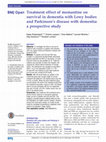
BMJ open, 2014
To investigate the effect on survival of treatment with memantine in patients with dementia with ... more To investigate the effect on survival of treatment with memantine in patients with dementia with Lewy bodies (DLB) and Parkinson's disease with dementia (PDD). 75 patients with DLB and PDD were included in a prospective double-blinded randomised placebo-controlled trial (RCT) of memantine, of whom long-term follow-up was available for 42. Treatment response was recorded 24 weeks from baseline and measured by Clinical Global Impression of Change (CGIC). The participants were grouped as responders (CGIC 1-3) or non-responders (CGIC 4-7). The 24-week RCT was followed by open-label treatment and survival was recorded at 36 months. After 36-month follow-up, patients in the memantine group had a longer length of survival compared with patients in the placebo group (log rank x²=4.02, p=0.045). Within the active treatment group, survival analysis 36 months from baseline showed that the memantine responders, based on CGIC, had higher rates of survival compared with the non-responders (lo...
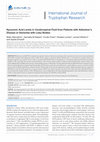
International journal of tryptophan research : IJTR, 2014
Kynurenic acid (KYNA) is implicated in cognitive functions. Altered concentrations of the compoun... more Kynurenic acid (KYNA) is implicated in cognitive functions. Altered concentrations of the compound are found in serum and cerebrospinal fluid (CSF) of patients with Alzheimer's disease (AD). Further studies to determine whether KYNA serves as a biomarker for cognitive decline and dementia progression are required. In this study, we measured CSF KYNA levels in AD patients (n = 19), patients with dementia with Lewy bodies (DLB) (n = 18), and healthy age-matched controls (Ctrls)) (n = 20) to further explore possible correlations between KYNA levels, cognitive decline, and well-established AD and inflammatory markers. Neither DLB patients nor AD patients showed significantly altered CSF KYNA levels compared to Ctrls. However, female AD patients displayed significantly higher KYNA levels compared to male AD patients, a gender difference not seen in the Ctrl or DLB group. Levels of KYNA significantly correlated with the AD-biomarker P-tau and the inflammation marker soluble intercellu...
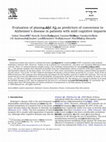
Numerous studies have shown a marked decrease of -amyloid 42 (A 42 ) in the cerebrospinal fluid... more Numerous studies have shown a marked decrease of -amyloid 42 (A 42 ) in the cerebrospinal fluid (CSF) of patients with incipient Alzheimer's disease (AD). However, studies on A in plasma are contradictory, and show very marginal differences between patients and controls. Here, we analyzed plasma samples using a new multiplex immunoassay for simultaneous analysis of A 1-40 , A n-40 , A 1-42 , and A n-42 . The plasma samples were obtained at baseline from two independent cohorts of patients with mild cognitive impairment (MCI) and age-matched controls. In the first cohort, 41% of the 117 MCI cases converted to AD during a clinical follow-up period of 4-7 years. In the second cohort, 14% of the 110 MCI subjects developed AD during a clinical follow-up period of 2-4 years. None of the plasma A isoforms differed between MCI patients that subsequently developed AD and healthy controls or stable MCI patients. The Cox proportional hazards model did not reveal any differences in the probability of progression from MCI to AD related to plasma A levels. In contrast, low levels of A 1-42 in CSF were strongly associated with increased risk of future AD. The absence of a change in plasma A in incipient AD, despite the marked change in CSF, may be explained by the lack of a correlation between the levels of A 1-42 in CSF and plasma. In conclusion, the results show that CSF biomarkers are better predictors of progression to AD than plasma A isoforms.
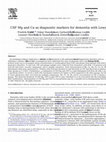
Accumulating evidence implicates a role for altered metal homeostasis in the pathogenesis of neur... more Accumulating evidence implicates a role for altered metal homeostasis in the pathogenesis of neurodegenerative disorders such as Alzheimer's disease (AD). However, few investigations have addressed this issue in dementia with Lewy bodies (DLB). The aim of the present study was to investigate metal concentrations in cerebrospinal fluid (CSF) and plasma from patients with DLB and other neurodegenerative disorders. To that end, CSF and plasma samples were collected from 29 patients with DLB, 174 patients with AD, 90 patients with AD with minor vascular components, and 51 healthy volunteers. Total concentrations of Mg, Ca, Mn, Fe, Cu, Zn, Rb, Sr, and Cs were determined using mass spectrometry. Patients with DLB had elevated Ca and Mg levels in CSF and Mg levels in plasma as compared to all other groups (p < 0.001). Furthermore, a combination of CSF-Mg and CSF-Ca could distinguish DLB from AD with a sensitivity of 93% and a specificity of 85%. Cu levels in both CSF and plasma tended to be higher in DLB compared to the other groups, but these trends failed to reach significance after correction for multiple comparisons. Mn, Fe, Zn, Rb, and Sr concentration in CSF or plasma were similar in all groups. The observed elevations of CSF-Mg, CSF-Ca and CSF-Cu may contribute to or be associated with the neurodegenerative process in DLB. Furthermore, determination of CSF-Mg and CSF-Ca concentration may be a valuable tool in distinguishing DLB from AD.

Human Molecular Genetics, 2014
Clinical and neuropathological similarities between dementia with Lewy bodies (DLB), Parkinson's ... more Clinical and neuropathological similarities between dementia with Lewy bodies (DLB), Parkinson's and Alzheimer's diseases (PD and AD, respectively) suggest that these disorders may share etiology. To test this hypothesis, we have performed an association study of 54 genomic regions, previously implicated in PD or AD, in a large cohort of DLB cases and controls. The cohort comprised 788 DLB cases and 2624 controls. To minimize the issue of potential misdiagnosis, we have also performed the analysis including only neuropathologically proven DLB cases (667 cases). The results show that the APOE is a strong genetic risk factor for DLB, confirming previous findings, and that the SNCA and SCARB2 loci are also associated after a study-wise Bonferroni correction, although these have a different association profile than the associations reported for the same loci in PD. We have previously shown that the p.N370S variant in GBA is associated with DLB, which, together with the findings at the SCARB2 locus, suggests a role for lysosomal dysfunction in this disease. These results indicate that DLB has a unique genetic risk profile when compared with the two most common neurodegenerative diseases and that the lysosome may play an important role in the etiology of this disorder. We make all these data available.
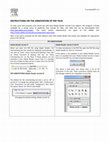
The American journal of geriatric psychiatry : official journal of the American Association for Geriatric Psychiatry, 2014
To determine whether the 5HTTLPR serotonin transporter polymorphism is associated with delusions ... more To determine whether the 5HTTLPR serotonin transporter polymorphism is associated with delusions and hallucinations in people with dementia with Lewy bodies (DLB) and Parkinson disease dementia (PDD). Prospective cohort study. A total of 187 individuals, recruited from centres in Norway, Sweden, and the United Kingdom were included in this study; 97 with clinically or neuropathologically diagnosed DLB/PDD and 90 cognitively normal individuals as a comparison group. All participants with dementia underwent serial evaluation of neuropsychiatric symptoms to assess the presence of persistent delusions and hallucinations using the Columbia University Scale for Psychopathology in Alzheimer disease, the Neuropsychiatric Inventory, or the Present Behavioural Examination. Severity of cognitive impairment was measured using the Mini Mental State Examination (MMSE). Individuals were genotyped for the 5HTTLPR polymorphism. Logistic regression demonstrated that homozygosity for the L/L genotype ...

Neurodegenerative Diseases, 2008
Identifying individuals at high risk of developing Alzheimer&amp;amp;#39;s disease (AD) is im... more Identifying individuals at high risk of developing Alzheimer&amp;amp;#39;s disease (AD) is important for future therapeutic strategies, and there is a clinical need for diagnostic biomarkers to identify incipient AD. The aim of the present study was to investigate if the AD-associated Abeta peptide pattern recently found in cerebrospinal fluid (CSF) could discriminate between patients with incipient AD and those with stable mild cognitive impairment (MCI) by analyzing CSF from patients with MCI at baseline. The levels of Abeta(1-37, -38, -39, -40, -42) were analyzed by Abeta-SDS-PAGE/immunoblot in CSF from 19 healthy controls, 25 patients with stable MCI and from 25 patients with MCI who later developed AD during 4- to 6-year follow-up. All healthy controls and 20 out of 22 patients who developed AD were correctly classified by their baseline Abeta peptide pattern. In 9 out of 25 stable MCI patients, the pattern indicated incipient AD in spite of clinical nonconversion. Interestingly, these individuals had apolipoprotein E genotypes and CSF levels of tau and phospho-tau that are known to be associated with high risk of AD. Altogether, our study reveals the novel finding that the Abeta peptide pattern is able to predict AD in patients with MCI with a sensitivity of 91% and specificity of 64%. The specificity would increase to 94% if the high-risk patients in the stable MCI cohort developed AD during extended follow-up.
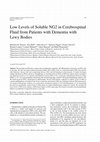
Journal of Alzheimer's disease : JAD, 2014
The proteoglycan NG2 plays a major role in proliferation, migration, and differentiation of peric... more The proteoglycan NG2 plays a major role in proliferation, migration, and differentiation of pericytes and NG2 cells in the brain. We have previously reported decreased soluble NG2 (sNG2) levels in cerebrospinal fluid (CSF) from patients with Alzheimer's disease (AD) and a relationship between sNG2 and AD biomarkers in these patients. To further investigate whether alterations in sNG2 is specific to AD pathology, we measured levels of sNG2 in CSF from a patient cohort consisting of non-demented controls (n = 51), patients with Parkinson's disease (PD) (n = 61), and patients with dementia with Lewy bodies (DLB) (n = 37), two synucleinopathies whereof the latter disorder frequently coincides with amyloid-β pathology similar to AD. We found decreased sNG2 concentrations in DLB patients, but not in PD patients, compared to controls. Levels of sNG2 in controls and PD patients correlated to T-tau, P-tau, α-synuclein, and neurosin. Only one correlation, between sNG2 and neurosin, wa...
PLoS ONE, 2009
Background: The CSF biomarkers tau and Ab42 can identify patients with AD, even during the precli... more Background: The CSF biomarkers tau and Ab42 can identify patients with AD, even during the preclinical stages. However, previous studies on longitudinal changes of tau and Ab42 in individual patients with AD and elderly controls report somewhat inconsistent results.

Uploads
Papers by Elisabet Londos